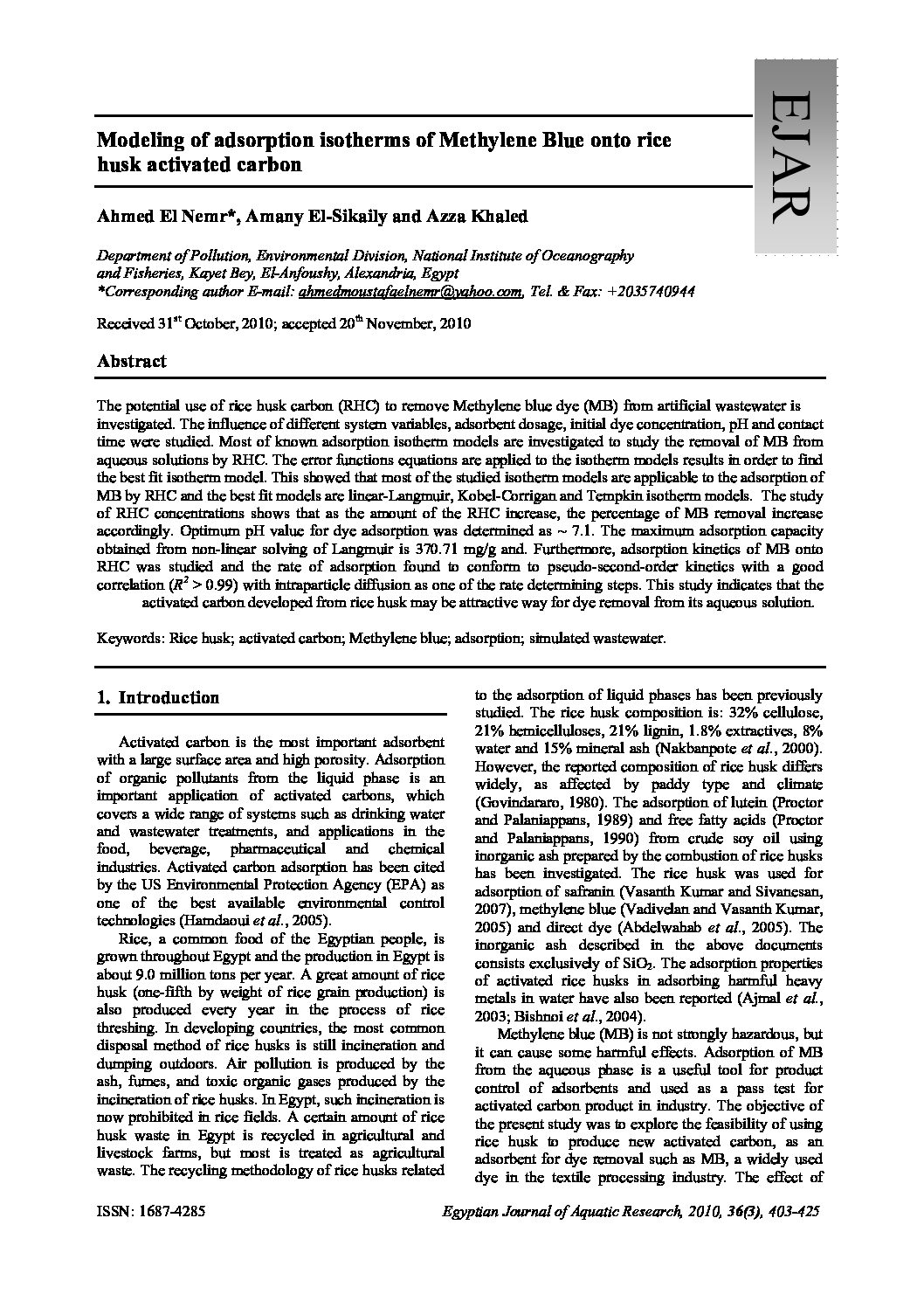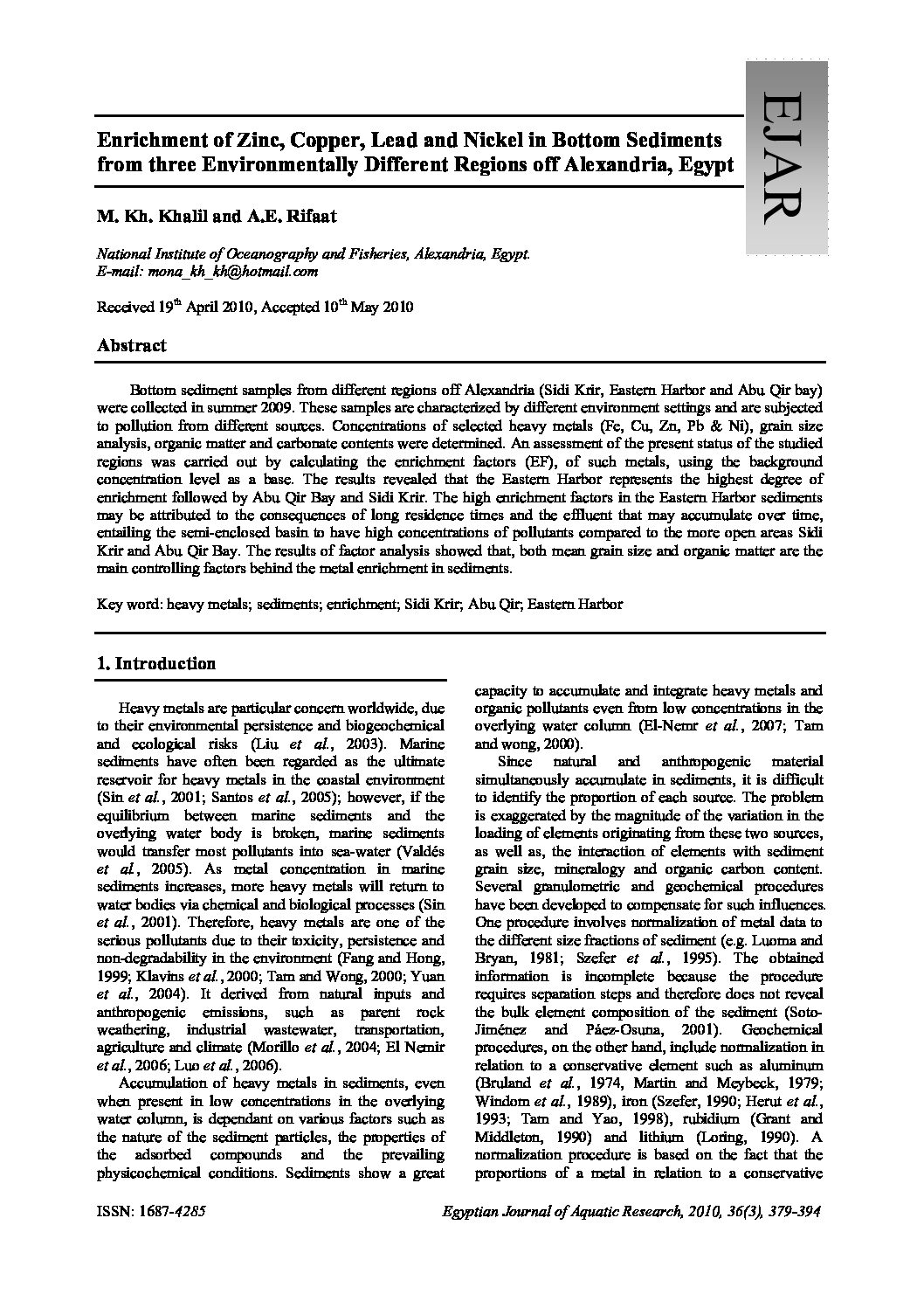Modeling of adsorption isotherms of Methylene Blue onto rice husk activated carbon
Modeling of adsorption isotherms of Methylene Blue onto rice husk activated carbon Ahmed El Nemr*, Amany El-Sikaily and Azza Khaled Department of Pollution, Environmental Division, National Institute of Oceanography and Fisheries, Kayet Bey, El-Anfoushy, Alexandria, Egypt *Corresponding author E-mail: [email protected], Tel. & Fax: +2035740944 Received 31st October, 2010; accepted 20th November, 2010 Abstract The potential […]
Improving Androgenesis by optimizing conditions of ultraviolet treatment in Nile tilapia, Oreochromis niloticus (L.) Zaki Sharawy1 & 2 1 National institute of Oceanography and Fisheries, P. O. Box 182, Suez, Egypt 2 Institute for Hydrobiology and Fisheries Science, Hamburg University, Olbersweg 24, D-22767 Hamburg, Germany E-mail: [email protected] Received 8th March 2010, Accepted 20th October 2010 Abstract The objectives of the present study were to produce homozygous male in Nile tilapia (Oreochromis. niloticus), where the male is heterogametic, by using UV-irradiation and heat shock treatments. Nile tilapia, O. niloticus brood stock was collected from the Lake Manzala population, Egypt and send to the Institute for Animal Breeding and Genetics, Goettingen, Germany, where this experiment was carried out. Fertilization of ultraviolet (UV) irradiated eggs was carried out by using a dosage of 254 nm at a fixed intensity of 58 mJ/cm2 for different distances between UV-lamp and eggs via a heat-shock (41°C for 5 min started at 4.5 min post-fertilization) of Nile tilapia, O. niloticus with sperm from homozygous O. niloticus males induced by mitotic gynogenesis from the second and the third generations of low and high temperature sensitive selection induced. Treatment of eggs at 5 cm distance before fertilization proved to be sufficient to inactivate egg DNA. The present results showed that for the values of a sex ratio of gynogenetic males was mated with normal females (one male x one female) for control group with a lowest percentage of males (14%) and the highest percentage was 44%. For the experimental treatment groups, the results obtained that, at hatching stage (4 days post-fertilization), survival ranged from 0.57% to 3.50%. Although high survival rates were obtained at the hatching stage, they sharply decreased by the yolk-sac absorption stage and dropped by the swim-up stage (30-150 day post-fertilization). Sex ratio of all the progeny (treated groups) significantly differed from 1:1 while their respective controls did not significantly differ from the expected 1:1 ratio (P>0.05), with exception of one male which produced 14% male progeny. After testing the homozygous of fishes, they will be used to produce subsequent generation of androgenetic strains. This study may indicate successfully inactivated the maternal genome (nuclear DNA) in Nile tilapia eggs at 5 cm distance using UV-irradiation. Keywords: Oreochromis niloticus, monosex, sex ratio, androgenesis, haploidy, diploidy
Improving Androgenesis by optimizing conditions of ultraviolet treatment in Nile tilapia, Oreochromis niloticus (L.) Zaki Sharawy1 & 2 1 National institute of Oceanography and Fisheries, P. O. Box 182, Suez, Egypt 2 Institute for Hydrobiology and Fisheries Science, Hamburg University, Olbersweg 24, D-22767 Hamburg, Germany E-mail: [email protected] Received 8th March 2010, Accepted 20th October 2010 […]
Enrichment of Zinc, Copper, Lead and Nickel in Bottom Sediments from three Environmentally Different Regions off Alexandria, Egypt
Enrichment of Zinc, Copper, Lead and Nickel in Bottom Sediments from three Environmentally Different Regions off Alexandria, Egypt M. Kh. Khalil and A.E. Rifaat National Institute of Oceanography and Fisheries, Alexandria, Egypt. E-mail: [email protected] Received 19th April 2010, Accepted 10th May 2010 Abstract Bottom sediment samples from different regions off Alexandria (Sidi Krir, Eastern Harbor […]
Effect of exogenous hormonal treatment on growth, survival and mucous cell activity during larval development of Oreochromis niloticus
Effect of exogenous hormonal treatment on growth, survival and mucous cell activity during larval development of Oreochromis niloticus Mohamed A. Al-Absawey National Institute of Oceanography and Fisheries Kayet Bey, Alexandria, Egypt Email: [email protected] Received 5th March 2010, Accepted 27th July 2010 Abstract In Oreochromis niloticus larvae treated with cortisol (C0.1 ppm); L- Thyroxin (T0.05 or […]
DNA fingerprinting of some tilapia fish in Suez Canal zone
DNA fingerprinting of some tilapia fish in Suez Canal zone Mohamed E. Megahed1*, Mahmoud M. Rifaat2 , Mohamed A. EL Danasoury1 , Safaa M. Sharaf1 1 Department of Animal Production and Fish Resources, Faculty of Agriculture, Suez Canal University, Ismailia, 41522. 2 Department of Plant Genetics, Faculty of Agriculture, Suez Canal University, Ismailia, 41522. *Email: […]
Distribution of copper and zinc in Aswan dam reservoir and River Nile water at Aswan, Egypt
Distribution of copper and zinc in Aswan dam reservoir and River Nile water at Aswan, Egypt Mohamed, E.F. Toufeek Chemistry department, National Institute of Oceanography and fisheries, Egypt [email protected] Received 7th October 2010, Accepted 1st December 2010 Abstract The present study deals with the factors affecting the distribution of copper and zinc in Aswan Reservoir […]
Developmental toxicity of nonylphenol in zebrafish (Danio rerio) embryos
Developmental toxicity of nonylphenol in zebrafish (Danio rerio) embryos Tamer El-Sayed Ali Oceanography Department, Faculty of Science, Alexandria University, Egypt. E-mail: [email protected] Received 5th June 2010, Accepted 27th July 2010 Abstract Nonylphenol (NP) is a widely used industrial organic compound that enters the environment as a microbial degradation product of nonylphenol polyethoxylates (NPEs), being ubiquitous […]
Comparative study of the antibacterial activity of Ulva lactuca and Pterocladia capillacea extracts before and after encapsulation in Ca-alginate beads
Comparative study of the antibacterial activity of Ulva lactuca and Pterocladia capillacea extracts before and after encapsulation in Ca-alginate beads Aida H. Shobier1 , Sahar Wefky2 , Safaa A. H. Abdel Ghani3 and El Sayed H. El Ashry4 1 Marine Pollution Lab, 2 Microbiology Lab, 3 Marine Chemistry Lab, Division of Marine Environment, National Institute […]












